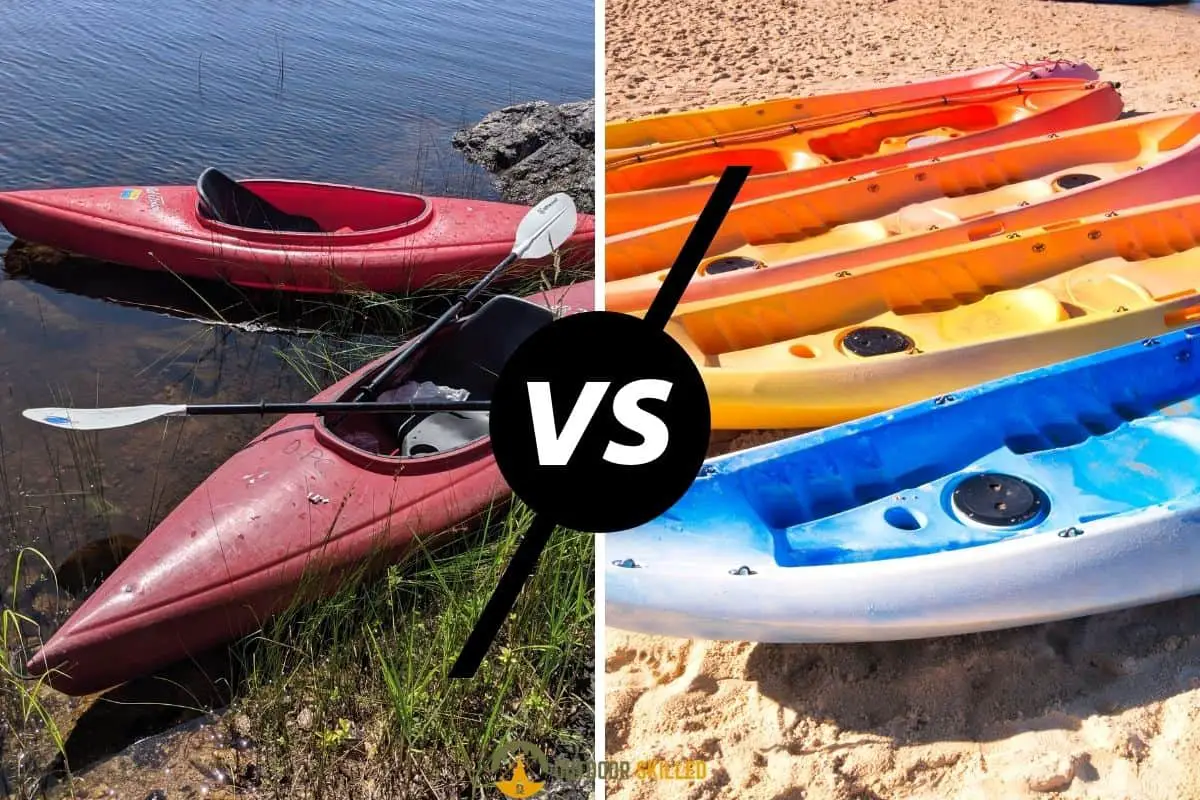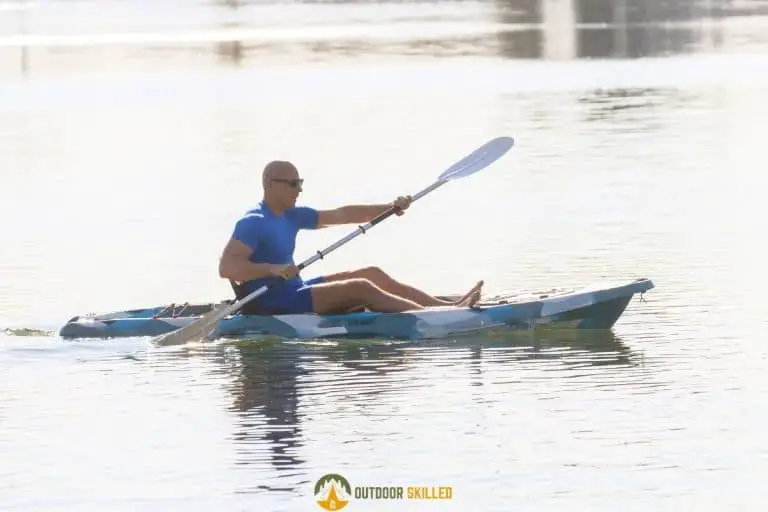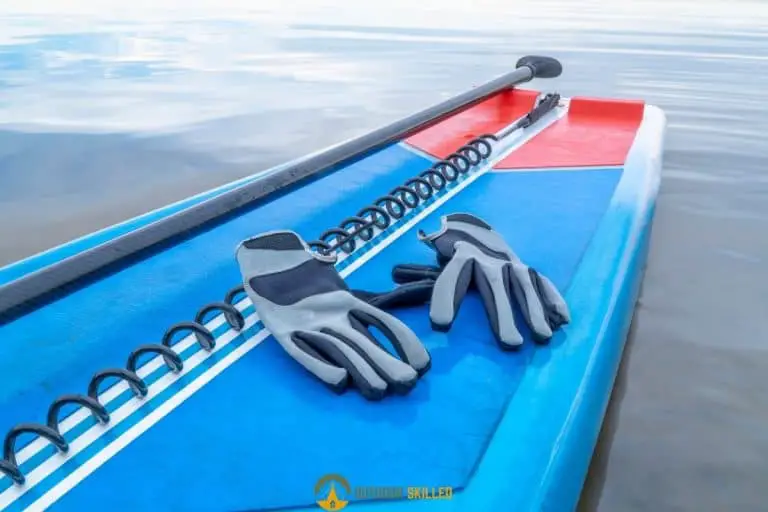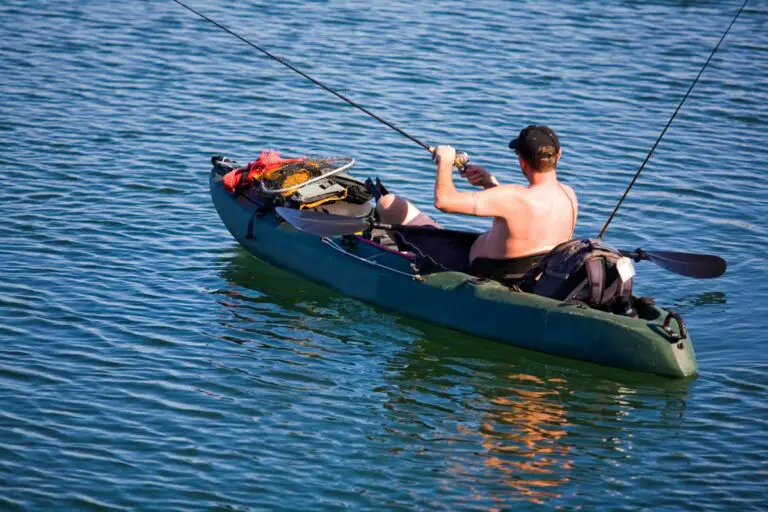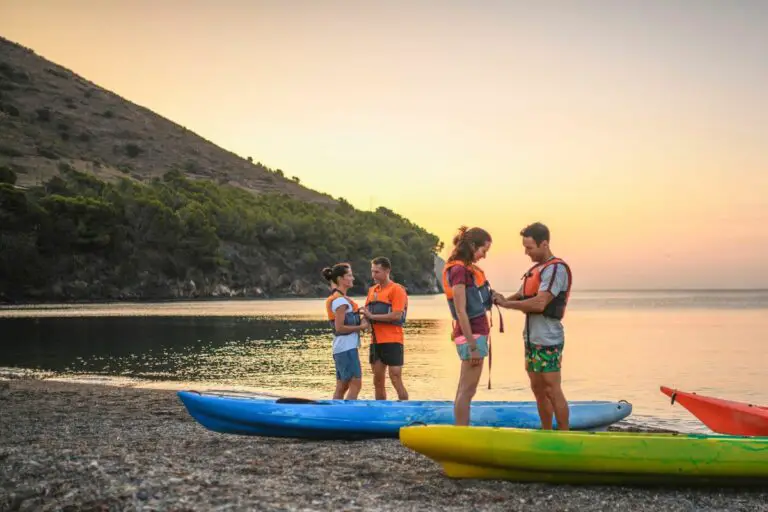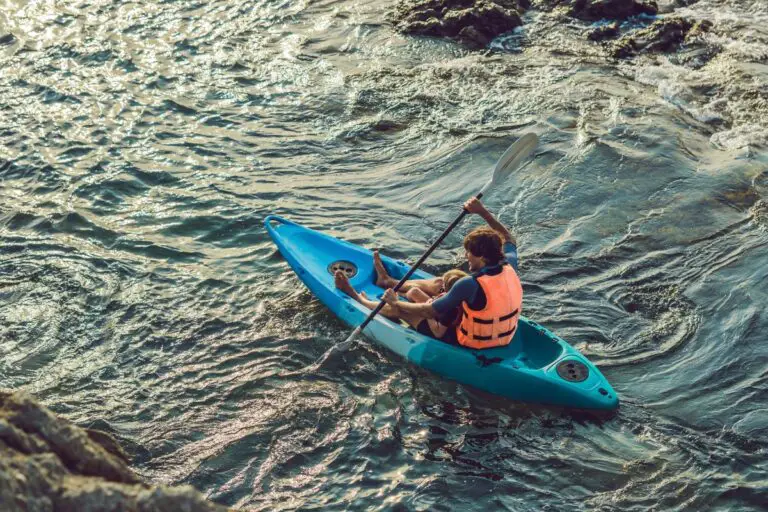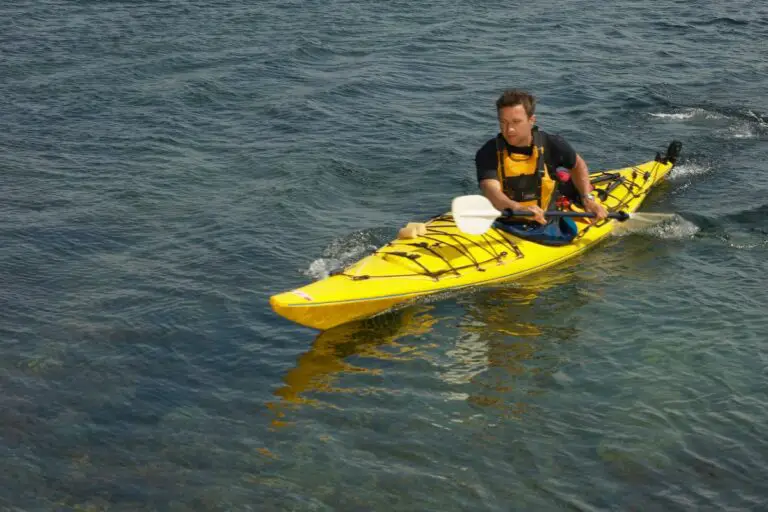Sit-on-Top vs Sit-in Kayak – Pros, Cons, and Which is Better for You
Choosing a kayak is not an easy task. Kayaks are mainly divided into two designs which are sit-on-top and sit-inside. Each design is significantly different from the other and each has a distinct set of advantages and disadvantages.
This article will help give you a detailed breakdown of the pros and cons for each type so that you can choose the kayak style that fits your needs and experience level. If you’re in a hurry, you can skip right ahead to the best kayaks for beginners at the end or check the best budget Kayaks here.
Table of Contents
The Pros and Cons of Sit-On-Top Kayaks

Sit-on-top kayaks (also known as SOTs for short) are designed without an enclosed cockpit which enables the paddler to be above the kayak deck instead of being positioned inside the kayak below the water level.
Everything from footwells to the seatback is also positioned on top of the kayak’s deck with no way to reach the inside of the kayak except through storage hatch openings.
They are manufactured with four holes in the floor of the kayak known as scupper holes. The purpose of these holes is to act as a draining system for water that comes on the deck and prevent it from pooling below the paddler.
Now let’s take a look at the advantages and disadvantages of sit-on-top kayaks:
Advantages
- They’re ideal for beginners – they’re ideal if you’re new to kayaking because they’re easy to use.
- They’re safer – They’re considered to be unsinkable due to the lack of a cockpit. They also have scupper holes that let the water drain out in case of an accidental capsize.
- They offer a good amount of stability – They have a high center of gravity and they’re relatively wide. This gives them a higher degree of initial stability which allows the kayak to remain upright.
- They’re easier to board — Since there’s no cockpit to lower down, they can be easily re-entered from the water. With very little effort, you will be able to pull yourself back up onto the deck and reposition yourself for paddling.
- They’re suited for multi-person use — Sit-on kayaks can carry hundreds of pounds of weight. Many of them are rated safe for 500 or more pounds meaning they can carry two or three paddlers, so they’re great for tandem use.
- They can be easily customized — Many sit-on kayaks can easily be modified to fit your wants and needs. You can add accessory mounts for fishing poles, GPS devices or cameras, rudders, and even motors.
- They come with various pedal and rudder options — Some sit-on kayaks are built with foot-driven pedals and hand-operated rudders. This allows for higher speed, more control, and can be perfect for a full body workout.
- They’re cheaper – A lot of quality sit-on-top kayaks come at a reasonable price with the exception of sit-on-top kayaks that are designed for fishing, they can be slightly more expensive.
Disadvantages
- They’re not ideal for rough water and harsh conditions — Because of the open cockpit, sit-on kayaks offer no protection from the elements.
- They have very limited dry storage space — Sit-on kayaks often have at least one or two dry storage hatches, but they’re very small in size.
- They’re very heavy to carry out of the water — It can be a struggle to transport your sit-on-top kayak.
- They’re relatively slower – Because of their wide beam, sit-on-top kayaks can be slow which requires excreting more effort from the paddler to push them forward.
When Is It Best to Use a Sit-On-Top Kayak?
- Sit-on-top kayaks are the best option for casual paddlers or people who are completely new to kayaking and want to learn how to kayak.
- They’re the best for fishermen because many of them are specifically designed to suit fishermen’s needs.
- They’re ideal for families because they are safe enough to let the kids use them.
- They’re also an excellent option for people with mobility issues or those who may be claustrophobic.
- Finally, they’re the best suited for kayaking in warm weather and still water.
The Pros and Cons of Sit-In Kayaks

Sit-insides are also known as SIK for short. Their design is more traditional as it includes an open cockpit, so the paddler can sit inside the hull of the kayak and below the water surface instead of being positioned on top of the kayak.
They do not have scupper holes, so paddlers have to use other methods to remove water from the cockpit such as manually operated or a battery operated bilge pump.
Now let’s take a look at the advantages and disadvantages of sit-inside kayaks:
Advantages
- They’re suited for long distance trips — They’re faster which allows paddlers to use them during multi-day river-camping trips or even for commuting.
- They offer more maneuverability — Due to the presence of a cockpit, paddlers can brace their knees against the underside of the deck which increases the efficiency of their strokes and allows more control over the kayak.
- They can be faster – They have a low center of gravity and a narrower beam, they can be much faster. So, they require less effort from the paddler to push them forward.
- They have lots of storage space — Most sit-in touring kayaks offer boaters plentiful dry storage compartments built into the hulls.
- They’re more suited for rough waters — Also because of their low center of gravity, they have a much higher degree of secondary stability. This allows the paddler to be able to lean the kayak on its side with more efficiency when turning as well as remain upright when paddling in rough seas.
- They’re light in weight — Most sit-in kayaks are made of blow-molded plastic, making them lightweight enough to be easily transported.
- They provide more protection from the elements – A spray skirt can easily be attached to cover the opening of the cockpit and close of the hull to protect the paddler and prevent water from entering the kayak and onto the paddler’s legs.
Disadvantages
- They’re difficult to enter – In case of an accidental capsize, a sit-inside kayak can be complicated to reenter because it will likely be filled with water.
- They’re not ideal for beginners – They require more skill to control and are not very suited for learning or just casual use.
- They’re not very safe – They can be sunk if both of the hatch covers come off in rough water or if both the bow and stern holds become filled with water. They can also make paddlers feel like they’re confined inside.
When Is It Best to Use a Sit-In Kayak?
- Sit-in kayaks are the best option for intermediate or advanced kayakers who are looking to do specific types of activities.
- They’re suited for ocean touring, surf kayaking, and river kayaking; both whitewater and long distance river runs as well as racing.
- They’re also good for campers who go on multi-day paddling trips or for paddlers who use kayaks to commute for long distances.
- And finally, they’re the best for kayaking in colder weather and rougher waters.
Too much text? Consider this simple infograph with all the basics you need to know:

Feel free to share and pin this infographic.
Sit-on-top VS Sit-in Kayaks: Which is better for fishing?

Most fishing kayaks are sit-on-tops and some sit-on kayaks are even specifically designed for anglers, they come with built-in rod holders and standing platforms.
Sit-on-top kayaks are better for fishing as they offer a good range of motion for casting, trolling, and reeling in fish. They also allow anglers to stand up while fishing. And they have more space on the top of the deck to attach the fishing gear.
On the other hand, sit-in kayaks are not ideal for fishing. The presence of the cockpit limits the range of motion anglers need for casting and reeling. They also do not have the space for storing fishing rods and tackle boxes.
Yet, many anglers still choose to fish with sit-inside kayaks. That is because they prefer to stay dryer and warmer in colder weather, so sit-inside kayaks will offer them more protection from the elements.
How to Choose the Right Kayak for You?

Now that you know the advantages and disadvantages of both sit-on-top and sit-in kayaks, choosing the right style for you can be overwhelming.
However, there’s no need to worry. Your choice will mainly depend on your situation and the kind of experience you are looking to get, so the best way to narrow down your options is to identify how and where you’ll be using your kayak.
Here are some factors you should keep in mind to help you make your decision:
Material
- There are 7 different kinds of material to choose from. These include Kevlar, carbon fiber, inflatable plastic, fiberglass, wood, and hard plastic.
- Hard plastic is durable, but heavier in weight. While fiberglass is lighter in weight, but usually more durable.
- Carbon fiber and Kevlar can be even lighter in weight, but are much more expensive and usually not a good idea for beginners
- Wooden kayaks aren’t used much these days because they’re expensive to manufacture and they’re a lot heavier in weight.
Weight and load capacity
- Kayaks generally weigh between 20 and 80 pounds.
- Normally, sit-inside kayaks weigh less than sit-on-top kayaks. However, sit-on-top kayaks have a higher load capacity, so they can handle carrying more than one paddler.
Shape and design
- As explained before, the two types of kayaks are designed for different purposes and this has a great impact on their performance.
- A longer and narrower kayak will be faster. while a shorter and wider kayak will be more stable.
- Storage and onboard space
- The bigger your kayak is, the more space you’ll have for your gear.
- The differences in design between sit-on-top and sit-in kayaks will also affect the onboard space and storage options.
- Sit-on-top kayaks have an open deck with dedicated tank wells, bungee tie-down areas, and waterproof hatches that all allow for easy access.
- On the other hand, sit-in kayaks maximize under-the-deck storage by utilizing large bulkhead compartments that can be accessed through hatches.
Stability and safety
- Sit-on-top kayaks are usually wider and have a higher center of gravity, which means they have a higher degree of primary stability. On the other hand, sit-in kayaks are narrower and have a lower center of gravity, which means they have a significantly higher degree of secondary stability.
- When it comes to safety, both sit-on-top and sit-inside kayaks can be equally safe. So, your choice will depend on your level of experience.
Performance
- Performance mainly comes down to two things – speed and tracking.
- Speed is greatly affected by the kayak’s length and width. Both sit-on-top and sit-inside can be good when it comes to speed. However, sit-in kayaks are commonly considered faster because of their narrower design.
- The kayak’s handling and tracking, on the other hand, depend on the actual design of the kayak. The sit-in kayak’s design makes it much more maneuverable with better tracking performance.
Paddling environment
- You need to take into consideration the kind of weather you’ll be paddling in as well as where you’re fishing.
- Sit-On-top kayaks are generally better for calm waters and warmer weather. While sit-in can withstand rough waters and colder weather.
Seating and comfort
- In sit-on-top kayaks, the seat is positioned higher above the water level. It can be a molded-in seat or it can be attached to the deck. While in sit-inside kayaks you will be seated at water level and the hull will be covering most of your lower body.
- When it comes to comfort, one kind isn’t necessarily more comfortable than the other, it all depends on your preference.
Cost
- The price depends on several factors including the construction, materials, size, capacity, comfort features, and the intended use.
- Generally speaking, sit-in designs tend to be more expensive than sit-on-top designs.
If you’re looking for the best Kayaks that will not break your wallet, check out my recommended Kayaks under $1,000 here. I’ve found some kayaks that offer really good value for their price.
The Best Kayaks for Beginners
As a beginner, you need to carefully consider your options when it comes to purchasing a kayak. Make sure you research all options and go for what best fits your needs.
Here are some recommendations for the best kayaks for beginners:
The best Sit-On-Top kayak for beginners

The Sun Dolphin Journey is an ideal choice if you’re a beginner or if you’re looking for a fishing kayak.
- It has a wide frame which offers more stability and safety. It’s also good for still waters.
- It is made from a durable polyethylene material that is slightly UV-resistant. This will help keep the kayak intact when it hits rocks.
- Since it’s designed for fishing, it’s also light in weight and easy to carry. It also comes with a lot of storage options for your fishing gears as well as a portable accessory carrier and two mounts with a fishing rod holder.
- Its weight capacity is about 280 pounds which is considerably good. However, you will still need to take note of the gear and number of fish you bring abroad, so you won’t overload your boat.
- Its only drawback is that it’s not as fast when compared to other kayaks
The best Sit-In kayaks for beginners

The Sun Dolphin Aruba is one of the best kayaks for beginners in the market. It’s known for its comfortable design and it’s very affordable compared to other kayaks.
- It has a bigger storage area for your gear which allows you to store all your things without overloading the boat.
- It has a large cockpit and comes with a high back support. It also comes with foot braces that can be adjusted to keep your feet where you want them without feeling uncomfortable.
- It weighs only 40 pounds and can carry almost 250 pounds.
- It is made of UV stabilized polyethylene material. While that material can be durable, it can also show some fading after being exposed to sunlight for a long time.
- The only drawback in this kayak is that it’s more suited for slow rivers
Converting Sit-In Kayaks to Sit-On-Top
Some kayakers might get the idea of converting their sit-in kayaks to sit-on-top. This can be a good idea if you have an old sit-in and you’re looking to get the benefits of sit-on-top kayaks without having to purchase a new kayak. However, you would need to be careful if you’re going to DIY this project because you could accidentally do more damage to your kayak by using the wrong tools or parts.
Check this video to see how converting a sit-in kayak to a sit-on-top can be done:
What are Hybrid Kayaks?

Hybrid kayaks are also known as paddle board kayak hybrid or SUP kayaks. They’re basically a cross between a kayak and a paddle board. They combine the features of the two to create a more versatile vessel.
They are stable with a wide and open deck and you can paddle them from a standing position.
Their design includes a seat from which paddlers can use a double ended paddle to propel the vessel through the water. Some hybrid kayaks have seats built into the deck while other types have the seat on top of the deck.
The Pros and Cons of Hybrid Kayaks
Pros
- They offer various paddling positions – You can either be standing or sitting. Standing up gives you a better view of both the scenery around you and the water below you. Paddling when seated can be easier in the wind than when standing up.
- They are difficult to flip over – This can make them more child and pet friendly.
- They have lots of space – You can secure lots of gear with easy access.
- They are easy to transport – They are relatively lighter in weight which makes them easy to carry around.
Cons
- They don’t excel at any specific area of paddling – That is because they combine the features of two kinds of vessels.
- Their uses can be limited – They’re more suited for calm and still waters
Related Questions
How Hard Is It to Paddle Upstream in a kayak?
Paddling upstream in a kayak is not difficult. The paddler only needs to avoid the fast-moving middle sections of the river and stay closer to the edge. Averagely, a paddler can move at about 3.5 mph, so it’s recommended to avoid currents that go over this speed.
What Are the Differences Between a Hybrid Kayak and A Canoe?
The main difference is the purpose of canoes and hybrid kayaks. Canoes are used for transportation while hybrid kayaks are for more recreational uses. Another difference is that canoes have single blade paddles while hybrid kayaks have double blade paddles.
Helpful Resources & Interesting Reads
Determinants of kayak paddling performance
The effects of age, gender and level of experience on motivation to sea kayak
If you like this article, please share it or pin it, you can find the share buttons below. We will really appreciate it ❤️

